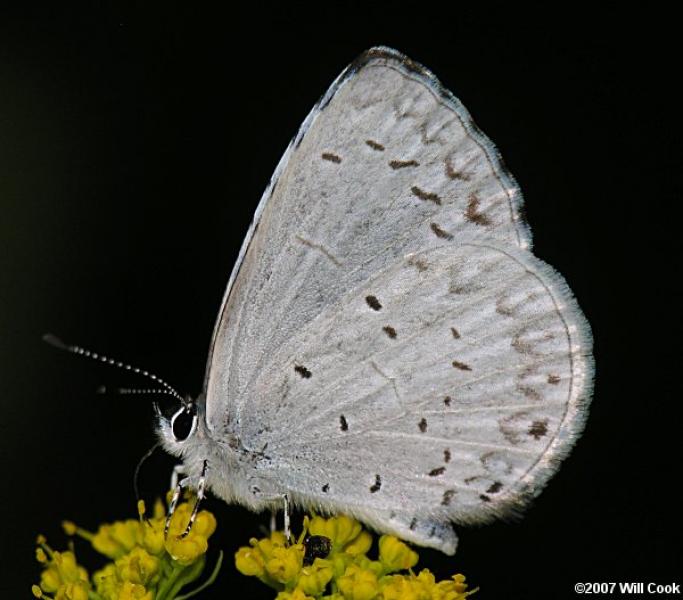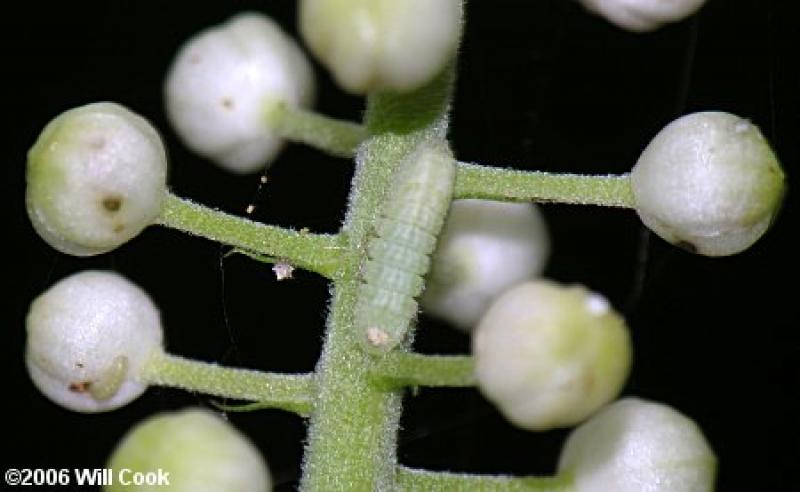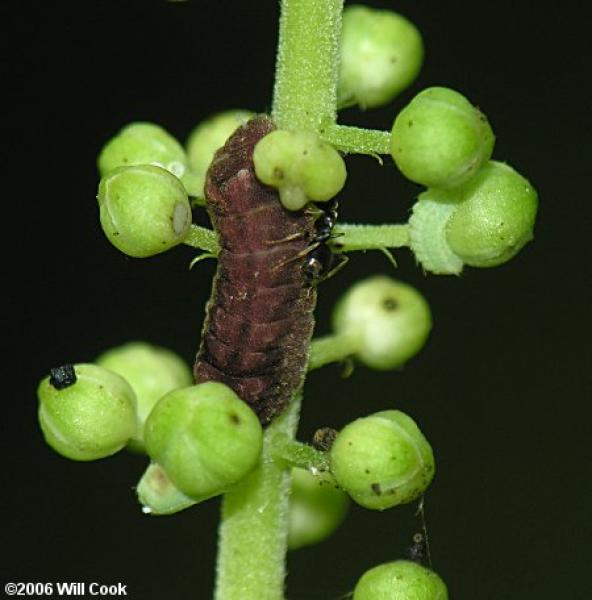Appalachian Azure
Celastrina neglectamajor Tutt, 1908
- Class
- Insecta (Insects)
- Family
- Lycaenidae (Blues, Coppers, Hairstreaks, Elfins)
- State Protection
- Not Listed
Not listed or protected by New York State.
- Federal Protection
- Not Listed
- State Conservation Status Rank
- S1S3
Critically Imperiled, Imperiled, or Vulnerable in New York - Conservation status is uncertain; could be especially vulnerable, very vulnerable, or vulnerable to disappearing from New York, due to rarity or other factors. More information is needed to assign either S1, S2 or S3.
- Global Conservation Status Rank
- G3?
Vulnerable globally (most likely) - Conservation status is uncertain, but most likely at moderate risk of extinction due to rarity or other factors; typically 80 or fewer populations or locations in the world, few individuals, restricted range, few remaining acres (or miles of stream), and/or recent and widespread declines. More information is needed to assign a firm conservation status.
Summary
Did you know?
In the 1960s all American azures were considered to be the same species. However, more recent research and collecting uncovered variation in specimens and foodplants determining that they were actually many species. Several common species have only been recognized since the late 1990s and more could be uncovered. New York has at least four species of Azures.
State Ranking Justification
This species has a very limited range in New York and appears to be scarce and local within it. Its habitat is generally threatened by deer and invasive plants, even where protected from development. There is some uncertainty as to the actual number of remaining colonies and more inventory and in some cases better documentation is needed, but there are likely to be between two and 20 populations in the state presently. It is expected that at least a few of these populations would have good prospects for persistence.
Short-term Trends
The short-term trend is unknown.
Long-term Trends
The long-term trend indicates a moderate to large decline (25 % to 90%) in the population.
Conservation and Management
Threats
The major threats are from development, which leads to habitat loss and alteration. Habitat fragmentation could be a serious issue since apparently this species is quite scarce (Glassberg 1993). In most areas, occupied habitats are probably too separated to allow much movement between patches. Besides development, invasive understory plants that can displace the foodplant, Black Cohosh (Actaea racemosa), are a serious threat. Deer are a potential threat, but may not impact the foodplant as severely as they do to some other understory flora. Deer potentially could eradicate a population virtually overnight by consuming the flowers of the foodplant and any eggs or larvae on them. More information is needed on this threat. Spongy moth (Lymantria dispar) spraying could be a threat depending on timing and whether or not the larvae would be sensitive to Btk (Bacillus thuringiensis var. kurstaki - a bacterial biological control used on spongy moths) applications. Harvest of the foodplant for alleged medicinal properties is a potential threat.
Conservation Strategies and Management Practices
Managing invasive understory plants like garlic mustard might be considered. If deer threaten the flowers of the foodplant, Black Cohosh (Actaea racemosa), then immediate action would needed to prevent this. In this scenario, a delay in action of just a few days could easily lead to loss of the population.
Research Needs
The most important need is to assess the degree of threat posed to the foodplant, Black Cohosh (Actaea racemosa), by deer and invasive plants. Deer consumption of the flowers or young fruit, and larvae on them, would be the issue. Also, identification of historical specimens need to be reverified to more precisely determine the distribution of this species.
Habitat
Habitat
The habitat is rich deciduous forest with the foodplant, Black Cohosh (Actaea racemosa) in the understory. Aside from sufficient foodplants, no other habitat needs are known.
Associated Ecological Communities
- Appalachian oak-hickory forest
(guide)
A hardwood forest that occurs on well-drained sites, usually on ridgetops, upper slopes, or south- and west-facing slopes. The soils are usually loams or sandy loams. This is a broadly defined forest community with several regional and edaphic variants. The dominant trees include red oak, white oak, and/or black oak. Mixed with the oaks, usually at lower densities, are pignut, shagbark, and/or sweet pignut hickory.
- Chestnut oak forest*
(guide)
A hardwood forest that occurs on well-drained sites in glaciated portions of the Appalachians, and on the coastal plain. This forest is similar to the Allegheny oak forest; it is distinguished by fewer canopy dominants and a less diverse shrublayer and groundlayer flora. Dominant trees are typically chestnut oak and red oak.
* probable association but not confirmed.
Range
New York State Distribution
This species occurs in the New York City area and has been reported as far north as Albany County. The current range in New York is somewhat uncertain due to unverified reports. The range of this butterfly is probably somewhat more restricted than the range of its foodplant, Black Cohosh (Actaea racemosa).
Global Distribution
This species occurs mostly in the mountains and piedmont from southeastern New York and western Connecticut to northern Georgia and west into the Ohio Valley. It is also found in southern Missouri.
Identification Comments
Identifying Characteristics
This could be very difficult or sometimes even impossible to identify from photographs since photographs may not convey size. Given the scarcity of the species, more than a single specimen should not be collected. In most cases collecting at least one male specimen should be strongly considered for newly discovered populations. Otherwise, several individuals should be photographed with a size reference included in the photographs. The adults are generally larger than other azures and are pale with reduced markings beneath, although summer azures could be very similar. A concentration of large pale azures in the vicinity of black cohosh in late May or early June would probably be Appalachian Azures. Summer Azure (Celastrina neglecta) larvae sometimes turn up on this foodplant, so the mere presence of Celastrina larvae on Black Cohosh (Actaea racemosa) is insufficient documentation.
Characters Most Useful for Identification
The adults are generally larger than other azures and are pale with reduced markings beneath, although summer azures could be very similar. A concentration of large pale azures in the vicinity of Black Cohosh in late May or early June would probably be Appalachian Azures. The flight season is a good clue for identification, as adults found in July or later are not Appalachian Azures.
Best Life Stage for Proper Identification
The identification should be based on an adult specimen if possible. Larvae in June probably cannot be reliably identified, due to possible occurrence of the Summer Azure (Celastrina neglecta) on the same foodplant.
Behavior
This is a localized forest understory azure found near Black Cohosh (Actaea racemosa).
Diet
The larvae feed on flowers and developing fruit of Black Cohosh (Actaea racemosa) only. The adults probably take nectar from other plants.
Best Time to See
There is one brood with adults present in approximately mid or late May to mid-June. A few larvae may be present into July. Most of the year is spent as pupae in the leaf litter or humus layer.
- Reproducing
- Larvae present and active
- Pupae or prepupae present
The time of year you would expect to find Appalachian Azure reproducing, larvae present and active, and pupae or prepupae present in New York.
Similar Species
- Summer Azure (Celastrina neglecta)
The larvae of the Summer Azure may also be found on the same foodplant.
Appalachian Azure Images
Taxonomy
Appalachian Azure
Celastrina neglectamajor Tutt, 1908
- Kingdom Animalia
- Phylum Arthropoda
(Mandibulates)
- Class Insecta
(Insects)
- Order Lepidoptera
(Butterflies, Skippers, and Moths)
- Family Lycaenidae (Blues, Coppers, Hairstreaks, Elfins)
- Order Lepidoptera
(Butterflies, Skippers, and Moths)
- Class Insecta
(Insects)
- Phylum Arthropoda
(Mandibulates)
Additional Resources
References
Allen, T.J., J.P. Brock, and J. Glassberg. 2005. Caterpillars in the field and garden. Oxford University Press, New York. 232 pp.
Brock, J. P., and K. Kaufman. 2003. Butterflies of North America. Kaufman Focus Field Guides, Houghton Mifflin Company, New York, NY 284 pp.
Glassberg, J. 1993. Butterflies through binoculars: A field guide to butterflies in the Boston-New York-Washington region. Oxford University Press: New York. 160 pp.
Glassberg, J. 1999. Butterflies Through Binoculars: The East. Oxford University Press, New York, New York. 400 pp.
Gochfeld, M. and J. Burger. 1997. Butterflies of New Jersey. Rutgers University Press: Rutgers, New Jersey. 327 pp.
Iftner, D. C. and D. M. Wright. 1996. Atlas of New Jersey Butterflies. Privately published by authors.
Iftner, D. C., J. A. Shuey, and J. V. Calhoun. 1992. Butterflies and Skippers of Ohio. Ohio Biological Survey Bulletin. New Series, Vol. 9, no. 1, xii + 212 pp., 40 color plates.
New York Natural Heritage Program. 2024. New York Natural Heritage Program Databases. Albany, NY.
O'Donnell, J.E., L.F. Gall., and D.L. Wagner, eds. 2007. The Connecticut Butterfly Atlas. State Geological and Natural History Survey of Connecticut, Department of Environmental Protection, Hartford. 376 pp.
Shapiro, A.M. 1974. Butterflies and skippers of New York State. Search 4:1-60.
Links
About This Guide
Information for this guide was last updated on: December 20, 2007
Please cite this page as:
New York Natural Heritage Program. 2024.
Online Conservation Guide for
Celastrina neglectamajor.
Available from: https://guides.nynhp.org/appalachian-azure/.
Accessed July 27, 2024.


